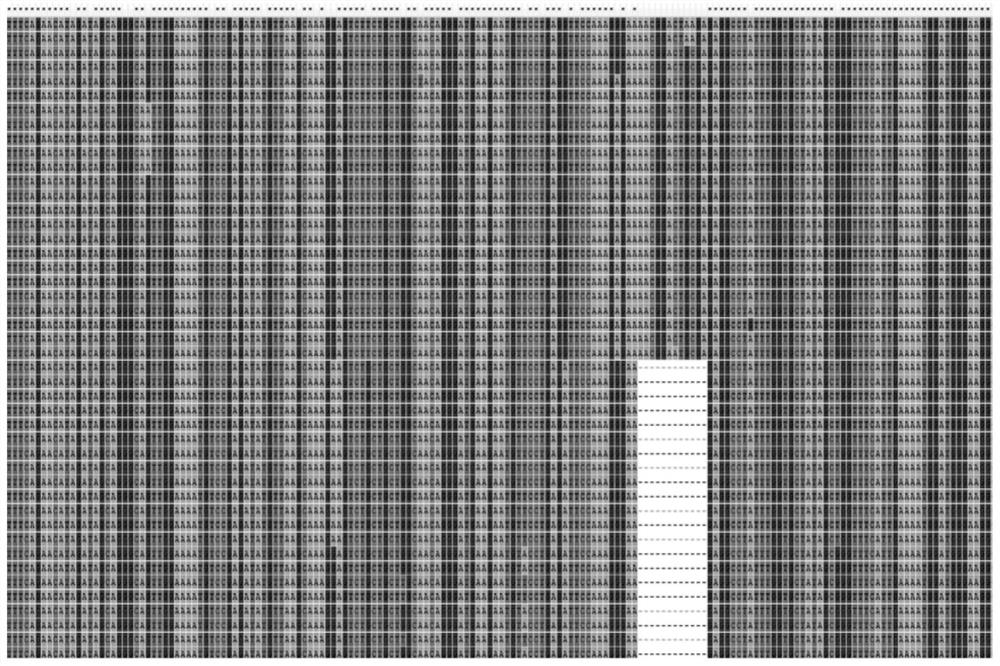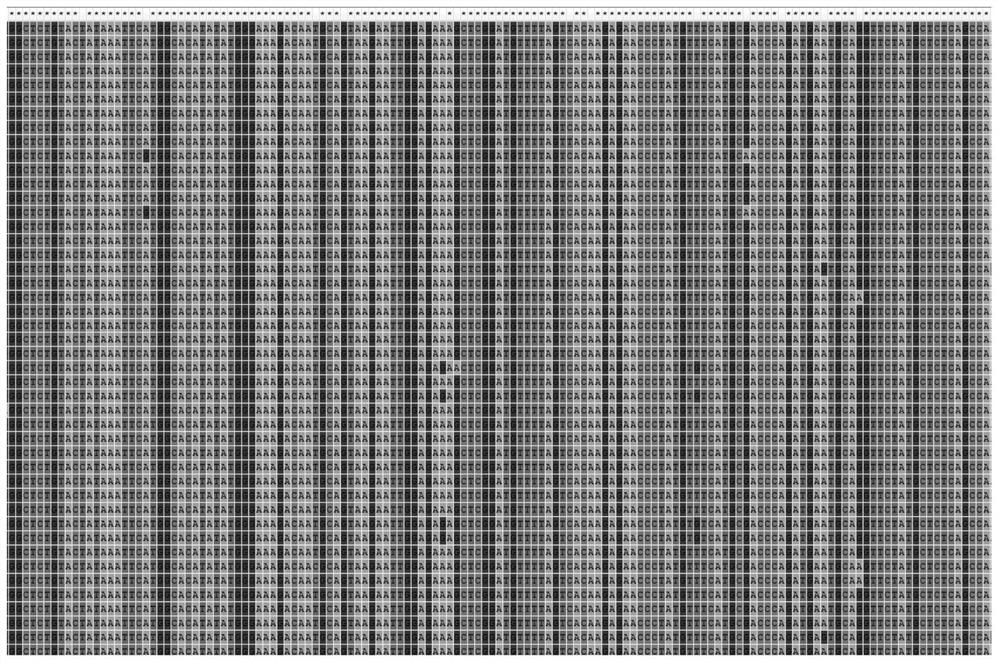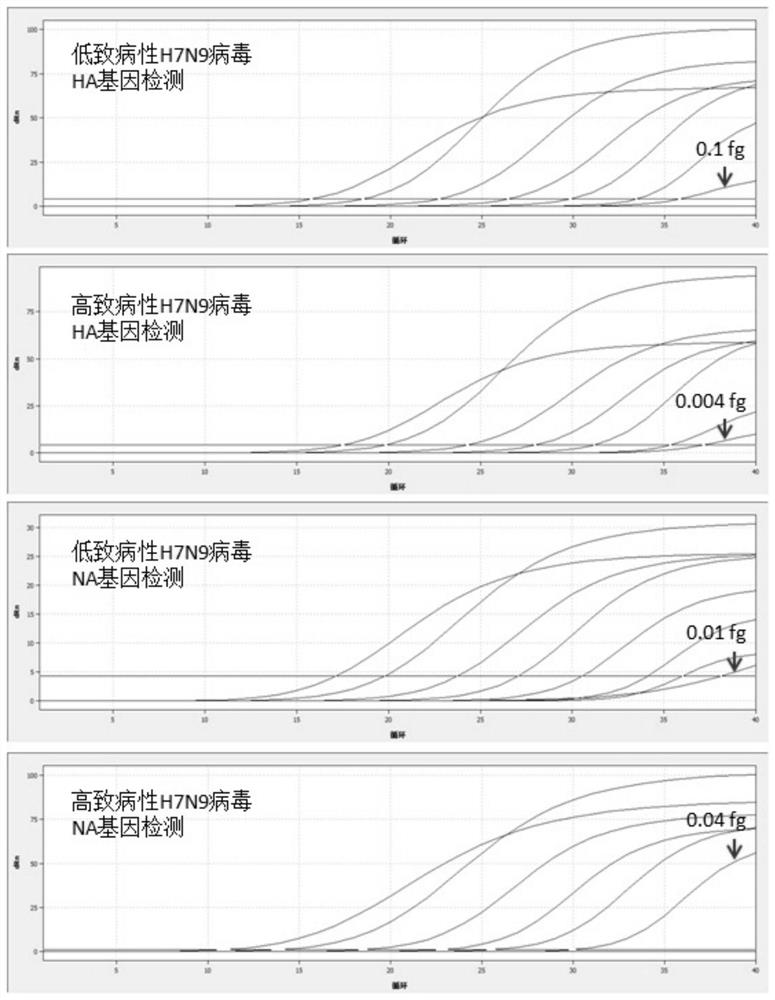A rapid detection method for distinguishing between strong and weak viruses of h7n9 subtype avian influenza virus
A bird flu virus, strong and weak technology, applied in the direction of biochemical equipment and methods, microbial measurement/inspection, recombinant DNA technology, etc., can solve the economic loss of poultry industry and other problems, achieve short detection time, high hardware requirements, long-term Effect
- Summary
- Abstract
- Description
- Claims
- Application Information
AI Technical Summary
Problems solved by technology
Method used
Image
Examples
Embodiment 1
[0030] Example 1: Determination of conserved sequence regions and screening of primer probes
[0031] The applicant studied the HA and NA nucleotide sequences (Table 1) of the virulent and attenuated H7N9 subtype avian influenza virus by molecular biology methods, and compared them with the HA sequences of the H7N9 strains isolated and preserved in the applicant's laboratory. Determine its conserved region ( figure 1 , figure 2 ). Sequence comparison found that the HA sequence of the strong and weak virus of H7N9 subtype avian influenza virus is in
[0032] nt907–nt956 region, the sequence of this region is as follows:
[0033] TTTCAGAACATWGAYAGCAGRRCARTTGGAAAATGYCCRAGATAKGTTAA;
[0034] nt964–nt995 region, the sequence is
[0035] AGTCTKCTGCTKGCWACAGGRATGAAGAATGT;
[0036] nt1028–nt1076 region, the sequence is
[0037] GAGGCCTRTTTGGTGCTATAGCDGGTTTCATTGAAAATGGATGGGAAGG is relatively conservative; wherein, R=A or G, Y=C or T, M=A or C, W=A or T, K=G or T.
[0038] Comp...
Embodiment 2
[0060] Embodiment 2: Establish detection method
[0061] After establishing the detection reaction system and reaction conditions, 25 μl of 2×RT-PCR reaction buffer (containing dNTPs, Mg 2+ ), 2.0 μl of upstream primers synthesized in the first step (concentration is 10 μmol / L), 2.0 μl of downstream primers synthesized in the first step (concentration is 10 μmol / L), 1.5 μl of probes synthesized in the first step (concentration 10 μmol / L), enzyme mixture (reverse transcriptase, RNase inhibitor, Taq enzyme with 5'→3' exo-cutting activity) 2.5 μl, viral nucleic acid to be detected 10.0 μl (from clinical samples or other samples extracted with a nucleic acid extraction kit); then the reaction system was sealed and placed on a fluorescent quantitative PCR instrument for reaction. Reaction conditions: first stage, reverse transcription 50°C / 10min; second stage, pre-denaturation 95°C / 2min; third stage, 95°C / 10s, 60°C / 30s, 40 cycles; Fluorescence was collected during the annealing e...
Embodiment 3
[0067] Embodiment 3: the effect detection of primer and probe
[0068] 1. The sensitivity test of the H7N9 subtype avian influenza virus was carried out using the primer probes and methods established by the above screening, including the following steps:
[0069] Step 1: Extract the RNA of H7N9 strong and weak strains respectively, and measure the viral RNA content with a micro-nucleic acid analyzer. Dilute the RNA by 10 times, take 10.0 μl of the diluted RNA template, and add it to 40.0 μl of qRT-PCR master mix;
[0070] The second step: use the established real-time fluorescent quantitative RT-PCR method to detect and determine its sensitivity;
[0071] The results show that the real-time fluorescence quantitative RT-PCR method established by the present invention has a detection limit of 0.004fg RNA template to the H7N9 strong poisonous HA gene, and a detection limit of 0.1fg RNA template to the H7N9 attenuated HA gene. The lower limit of detection is 0.04fg RNA template...
PUM
| Property | Measurement | Unit |
|---|---|---|
| Sensitivity | aaaaa | aaaaa |
Abstract
Description
Claims
Application Information
 Login to View More
Login to View More - R&D
- Intellectual Property
- Life Sciences
- Materials
- Tech Scout
- Unparalleled Data Quality
- Higher Quality Content
- 60% Fewer Hallucinations
Browse by: Latest US Patents, China's latest patents, Technical Efficacy Thesaurus, Application Domain, Technology Topic, Popular Technical Reports.
© 2025 PatSnap. All rights reserved.Legal|Privacy policy|Modern Slavery Act Transparency Statement|Sitemap|About US| Contact US: help@patsnap.com



